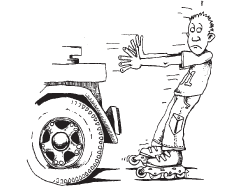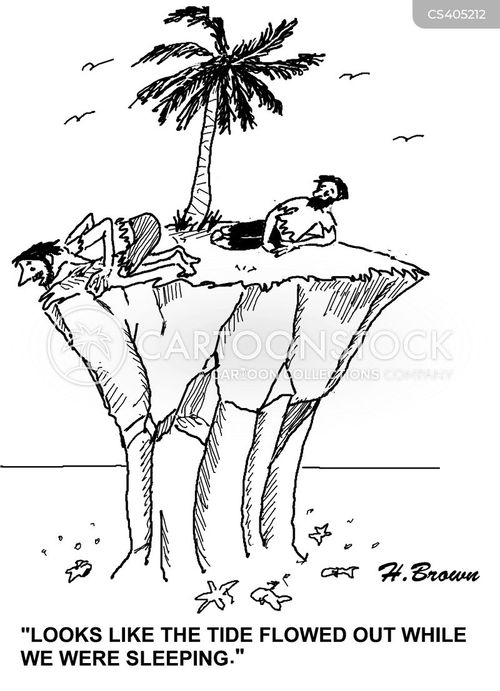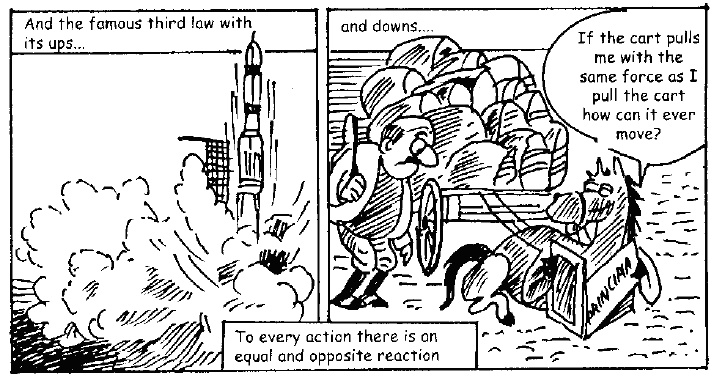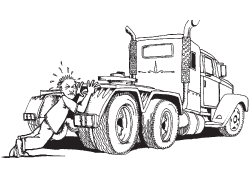Unit summary 3
Newton’s 3rd Law
The law states that any action has an equal and opposite
reaction. We did an interesting experiment in class with weighing scales. We hooked
them together and pulled, no matter how much we pulled the weight on each scale
was the same. The forces were equal and opposite. The opposite forces are
called an action reaction pair. An action reaction pair is the relationship
between the opposite forces. For example: the apple is on the table. The table
is pushing up the apple and the apple is pushing down the table. The forces in
the example are equal and opposite and are an action reaction pair. In this
case the earth pulls the apple down and the apple pulls the earth up. The earth
has an equal and opposite force to the table pushing up, but it is not an
action reaction pair because the pair can only be between two objects each affecting
the other.

Tug of War
The forces of an action reaction pair are always equal and opposite
so they cancel each other out creating a net force of 0. The way to move is the
differences in the forces produced. For example: to win a tug of war the
greater force has to be produced by the legs and the ground. No matter how hard
one pulls the rope they can never exert more force than the other person according
to the 3rd law. So one must have greater force between the legs and
the ground, the greater force on the ground will move the opponents forward
helping you win the tug of war. The key is to remember that you can never pull
harder than your opponents you must put more force on the ground than them.

Vectors
Vectors are lines with arrow heads that indicate the direction
and amount of force placed on an object. The vectors can be in any direction
and can be summed up to give the actual direction and amount of force. The vectors
are drawn to scale so the larger they are the large amount of force they
represent. Adding vectors that are parallel is simple as you add them and if they
are in opposite directions subtract. If they are at a 90 degree angle then use
the formula a^2+b^2=c^2. If you are adding vectors the have neither of these
conditions then create parallel line and form a closed figure. Where the new
parallel lines intersect is the direction and amount of force there.

Tides
The tides of the earth are low and high constantly
alternating in 6 hour intervals. The tides occur because of the difference in
force between the sides of the earth and the moon. The moon pulls on the water
on the close side of the earth towards it and the far side is pushed from the
moon. How is this possible? The moon creates a force on both sides of the earth
the force on the near side is stronger than the force on the far side. At the
same time the earth is pulling on both sides. The difference in net force on
each side of the earth because of the force of the moon creates mirroring high
and low tide on the sides of the earth. The difference in force is always opposite,
meaning that the force on the far side of earth is pulling the tide away from
the moon creating high tide. The strong high tides are called spring tides and
the strong low tides are called neap tides.
Momentum
Momentum is equal to mass*velocity. The mass and velocity
are both directly related to the momentum so if velocity increases the momentum
increases and if the mass increases the momentum increases. The momentum of an
object cannot be greater than the momentum of the object it is colliding with,
the total momentum before the collision is the same as the total momentum after
the collision. The change in momentum is called an impulse and impulse equals
force*time. The force and the time are both directly proportional to the
impulse, but the force is inversely proportional to the time. This means that
increasing the time before something hit another object reduces the force thus
reducing the damage.



 The horse and the cart do pull with equal and opposite forces but that is not the force that moves the cart. The cart is moved because the horses force on the ground is greater than the force of cart on the ground.
The horse and the cart do pull with equal and opposite forces but that is not the force that moves the cart. The cart is moved because the horses force on the ground is greater than the force of cart on the ground.  The 3rd Law applies to people (and talking animals) to, mostly in the form of revenge. If you are pushed then you push the person back.
The 3rd Law applies to people (and talking animals) to, mostly in the form of revenge. If you are pushed then you push the person back.
 Equilibrium
Equilibrium